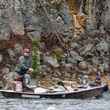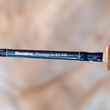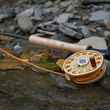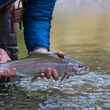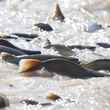A study published yesterday in the journal Environmental Science and Technology revealed disturbing new information about troubled Blacklick Creek in western Pennsylvania. The study, which sought to investigate the effects of the disposal of fracking wastewater by water treatment facilities into Pennsylvania's waterways, found vastly increased concentrations of naturally occurring radioactive materials in stream sediments near wastewater disposal sites. Concentrations of radium, a naturally occurring isotope that is 3 million times more radioactive than uranium, in these stream sediments were found to be around 200 times higher than both normal background levels of other area sediments including tested sediments from upstream locations.
Blacklick Creek, which is situated about an hour's drive from both the city of Pittsburgh and some of Pennsylvania's most storied trout waters, has a somewhat lengthy history of water quality issues thanks to acid mine drainage. After almost two decades of stream improvements efforts, however, the stream had begun to exhibit signs of life. A 2011 survey by the Pennsylvania Fish and Boat Commission found encouraging signs of fish beginning to return to the creek, with small specimens of eight different warm water species of fish discovered in the creek.










